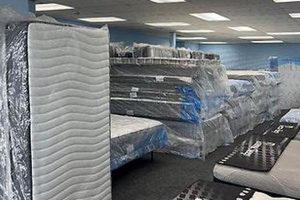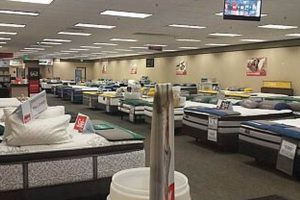Properly preserving a foam addition designed to enhance mattress comfort and support requires careful attention to several factors. This process aims to protect the material from damage, degradation, and the accumulation of dust or pests during periods of non-use. Examples of such practices include cleaning the item before storage, employing suitable protective coverings, and maintaining appropriate environmental conditions within the storage space.
The importance of appropriate preservation lies in extending the lifespan of the product, preserving its hygienic properties, and maintaining its structural integrity. Neglecting proper preservation can lead to compression, discoloration, mold growth, and reduced effectiveness, ultimately resulting in the need for premature replacement. Historically, methods for preserving bedding materials have evolved from simple airing and sunning techniques to more sophisticated approaches involving specialized cleaning agents and storage solutions.
The following sections will outline specific steps and considerations for ensuring the long-term viability and usability of foam mattress enhancements, including cleaning procedures, appropriate storage environments, and methods for preventing common forms of damage.
Preservation Strategies for Foam Mattress Enhancements
This section details actionable steps to optimize the preservation of foam mattress enhancements during periods of storage, maximizing their longevity and performance.
Tip 1: Cleaning Before Storage: Prior to stowing, thoroughly clean the enhancement. Use a mild detergent solution and a soft cloth to gently blot away stains or spills. Ensure complete dryness before proceeding to prevent mold or mildew formation.
Tip 2: Employ Protective Covering: Encapsulate the cleaned and dried enhancement in a breathable storage bag. Cotton or linen are preferable to plastic, as they allow for air circulation, mitigating moisture buildup.
Tip 3: Select a Climate-Controlled Environment: Choose a storage area characterized by stable temperature and humidity levels. Extremes in either direction can degrade the foam structure over time.
Tip 4: Avoid Compression: Store the enhancement in a flat, uncompressed state. Weight or pressure from other items can permanently deform the foam, reducing its effectiveness.
Tip 5: Implement Pest Control Measures: Ensure the storage area is free from pests. Consider using natural repellents, such as cedar chips or lavender sachets, to deter insects without damaging the foam.
Tip 6: Periodic Inspection: Regularly inspect the stored enhancement for signs of damage, discoloration, or odor. Early detection allows for corrective action, preventing further degradation.
Tip 7: Note Original Orientation: Mark the top and bottom surfaces before storage. This practice ensures consistent wear patterns when the enhancement is returned to use, promoting even distribution of compression and extending lifespan.
Implementing these preservation strategies will contribute significantly to the continued usability and comfort provided by the foam mattress enhancement.
The concluding section will offer a summary of the essential considerations for maintaining foam mattress enhancements and extend advice on recovering the product from storage.
1. Cleanliness
The cleanliness of a foam mattress topper prior to storage directly influences its condition and longevity during periods of non-use. Residual dirt, body oils, or spilled liquids can promote microbial growth, attract pests, and degrade the foam’s structural integrity. Therefore, a thorough cleaning regimen is a prerequisite for successful long-term preservation.
- Removal of Surface Debris
Surface debris, such as dust, hair, and skin cells, provides a breeding ground for dust mites and other allergens. Vacuuming the topper with a brush attachment before storage removes these particles, minimizing the risk of infestation and allergic reactions upon subsequent use. A clean surface also allows cleaning agents to more effectively penetrate and address deeper stains.
- Stain and Spill Treatment
Stains and spills, if left untreated, can become permanent and compromise the foam’s composition. Addressing stains with appropriate cleaning solutions prevents discoloration, odor development, and potential damage to the foam’s cellular structure. Enzyme-based cleaners are often recommended for organic stains, while mild detergent solutions can effectively remove general dirt and grime. Thorough drying after treatment is crucial to prevent moisture-related problems.
- Disinfection and Sanitization
Disinfecting the topper before storage reduces the risk of mold and mildew growth, particularly in humid environments. Solutions containing antimicrobial agents can eliminate bacteria and fungi, creating a more hygienic storage environment. However, it is essential to choose disinfectants that are safe for use on foam materials and to follow the manufacturer’s instructions carefully to avoid damage or discoloration.
- Complete Drying
Ensuring the topper is completely dry after cleaning is paramount. Residual moisture trapped within the foam creates an ideal environment for microbial growth, leading to unpleasant odors, material degradation, and potential health hazards. Air-drying the topper in a well-ventilated area, away from direct sunlight, is the recommended approach. The use of fans can accelerate the drying process and minimize the risk of moisture retention.
The implementation of these cleanliness measures directly contributes to the successful preservation of a foam mattress topper. By removing potential contaminants, preventing microbial growth, and ensuring complete dryness, the topper can be stored for extended periods without compromising its hygiene, comfort, or structural integrity, ensuring its readiness for future use.
2. Breathable Covering
The selection of an appropriate covering material constitutes a critical aspect of preserving foam mattress toppers during periods of storage. A breathable covering facilitates air circulation, mitigating the risk of moisture accumulation and subsequent degradation of the foam. The material’s characteristics directly influence the topper’s condition upon retrieval from storage.
- Moisture Regulation
Breathable materials, such as cotton or linen, allow moisture vapor to escape, preventing the creation of a humid microclimate within the storage bag. Trapped moisture can lead to the growth of mold, mildew, and bacteria, compromising the topper’s hygiene and structural integrity. Non-breathable materials, like plastic, restrict airflow and exacerbate moisture accumulation. For instan
ce, a cotton storage bag allows a topper stored in a moderately humid environment to maintain a stable moisture content, while a plastic bag might lead to condensation and subsequent microbial growth. - Odor Control
Breathable coverings contribute to odor control by facilitating the dissipation of volatile organic compounds (VOCs) that may be released from the foam over time. These VOCs can accumulate within enclosed spaces, leading to unpleasant odors and potential health concerns. Air circulation promoted by breathable materials helps to vent these compounds, maintaining a fresh and odor-free topper. Conversely, non-breathable materials trap VOCs, resulting in a concentrated odor that may be difficult to eliminate upon retrieval from storage.
- Prevention of Material Degradation
The ability of a covering to facilitate air circulation directly impacts the long-term structural integrity of the foam. Moisture accumulation can accelerate the breakdown of the foam’s cellular structure, leading to compression, loss of support, and reduced lifespan. Breathable materials help to maintain a dry and stable environment, minimizing the risk of degradation. As an example, a topper stored in a breathable cotton bag is less likely to exhibit compression or discoloration compared to one stored in a non-breathable plastic bag.
- Protection from Dust and Pests
While breathability is paramount, the covering must also provide adequate protection from dust, dirt, and pests. Tightly woven breathable materials offer a balance between air circulation and barrier protection. These materials prevent the ingress of dust mites, insects, and other contaminants that can compromise the topper’s hygiene and comfort. A tightly woven cotton cover, for example, provides sufficient protection against dust while still allowing for air circulation, whereas a loosely woven material might allow dust to penetrate.
In summary, the strategic selection of a breathable covering is an integral component of proper foam mattress topper storage. The material’s ability to regulate moisture, control odors, prevent material degradation, and protect against dust and pests directly contributes to the topper’s long-term preservation and continued usability.
3. Climate Control
Maintaining a stable and controlled climate is paramount when preserving foam mattress toppers during storage. Environmental conditions directly influence the physical and chemical properties of the foam, potentially leading to degradation if left unmanaged. Stable climate conditions are directly linked to proper storage.
- Temperature Stability
Extreme temperature fluctuations can compromise the structural integrity of foam. High temperatures accelerate chemical breakdown, leading to softening, discoloration, and reduced elasticity. Conversely, low temperatures can cause the foam to become brittle and prone to cracking. A consistent temperature within the range of 60-80F (15-27C) is generally recommended. For instance, storing a topper in an uninsulated attic exposed to summer heat can significantly shorten its lifespan compared to storing it in a climate-controlled basement.
- Humidity Regulation
Excessive humidity promotes the growth of mold, mildew, and bacteria within the foam matrix. These microorganisms degrade the foam, produce unpleasant odors, and pose potential health risks. Low humidity levels, on the other hand, can cause the foam to dry out and become brittle. Maintaining a relative humidity level between 30% and 50% is ideal. Storing a topper in a damp basement without a dehumidifier can create a breeding ground for mold, rendering it unusable, while storing it in an overly dry environment can cause it to lose its pliability.
- Air Circulation
Adequate air circulation within the storage area helps to prevent the buildup of moisture and odors. Stagnant air promotes microbial growth and the accumulation of volatile organic compounds (VOCs) released by the foam. Proper ventilation ensures a more stable and hygienic environment. Placing a topper in a sealed, unventilated container can trap moisture and VOCs, leading to odor problems and material degradation, whereas storing it in an open area with good airflow minimizes these risks.
- Protection from Direct Sunlight
Exposure to direct sunlight can cause fading, discoloration, and accelerated degradation of foam materials. Ultraviolet (UV) radiation breaks down the chemical bonds within the foam, leading to loss of elasticity and structural weakening. Storing a topper in a dark or shaded area minimizes UV exposure and prolongs its lifespan. Leaving a topper exposed to direct sunlight through a window can cause it to become brittle and discolored, significantly reducing its usable life.
These facets of climate control are inextricably linked to the successful long-term preservation of foam mattress toppers. By maintaining stable temperature and humidity levels, ensuring adequate air circulation, and protecting the topper from direct sunlight, one can significantly extend its lifespan and maintain its hygienic properties, ensuring its readiness for future use.
4. Avoid Compression
The principle of avoiding compression is a critical determinant in the successful long-term preservation of foam mattress toppers. Applied pressure during storage can permanently alter the foam’s cellular structure, diminishing its supportive capabilities and reducing overall comfort. Understanding the effects of compression is therefore essential to effectively store these items.
- Permanent Deformation
Sustained pressure on foam materials can lead to irreversible deformation of the cellular matrix. The individual foam cells collapse and lose their ability to rebound, resulting in a flattened area that compromises the topper’s ability to evenly distribute weight. An example would be stacking heavy boxes on top of a stored foam topper; the areas under the boxes will likely remain compressed even after the weight is removed. This directly impacts the topper’s future performance and comfort.
- Reduced Airflow and Increased Moisture Retention
Compression restricts airflow within the foam, creating an environment conducive to moisture accumulation. Compressed foam is less able to breathe, trapping moisture and potentially leading to mold or mildew growth. A topper stored under a heavy object in a humid environment is particularly susceptible. This moisture retention degrades the foam and fosters unsanitary conditions.
- Diminished Support and Pressure Relief
The primary function of a foam mattress topper is to provide enhanced support and pressure relief. Compression undermines this function by reducing the foam’s ability to conform to the body’s contours and alleviate pressure points. For instance, a compressed topper will feel less supportive under the hips and shoulders, negating its intended benefit. The resultant uneven support can lead to discomfort and disturbed sleep patterns.
- Accelerated Material Degradation
Sustained compression accelerates the overall degradation of foam materials. The constant stress on the cellular structure weakens the foam, making it more susceptible to tearing, crumbling, and loss of
elasticity. A topper that has been stored compressed will likely exhibit a shorter lifespan and diminished performance compared to one that has been stored properly. This compression essentially hastens the aging process of the foam.
These facets demonstrate that the act of avoiding compression is not merely a suggestion but a necessary practice for preserving foam mattress toppers. Proper storage techniques that minimize pressure are critical to maintaining the topper’s integrity, comfort, and useful life. Failure to do so can result in irreversible damage and a significantly diminished user experience.
5. Pest Prevention
Pest prevention forms an integral component of effective foam mattress topper preservation during storage. The porous nature of foam creates a conducive environment for various pests, necessitating proactive measures to safeguard the material from infestation and subsequent damage. A proactive approach significantly impacts the longevity and hygiene of the topper.
- Elimination of Food Sources
Insects and rodents are often attracted to stored items in search of food. Crumbs, spills, or even traces of body oils on a mattress topper can serve as attractants. Thoroughly cleaning the topper before storage to remove any potential food sources is crucial. For example, vacuuming and spot-cleaning the topper eliminate debris that might otherwise attract pests. This practice reduces the likelihood of infestation and associated damage.
- Physical Barriers
Utilizing physical barriers, such as tightly sealed storage bags, provides a primary defense against pest intrusion. The bag material should be durable and resistant to punctures or tears that could allow pests access. For example, storing a clean topper inside a zippered, pest-resistant storage bag prevents insects from reaching the foam. The integrity of the barrier is paramount to its effectiveness.
- Environmental Control
Maintaining a clean and dry storage environment discourages pest activity. Pests thrive in damp, cluttered conditions. Regular cleaning of the storage area and the use of dehumidifiers, if necessary, reduce the appeal of the space to pests. An example is storing the bagged topper in a clean, uncluttered closet rather than a damp basement. Controlling the storage environment limits pest habitation and proliferation.
- Repellents and Monitoring
Employing natural repellents, such as cedar chips or lavender sachets, can further deter pests without introducing harmful chemicals. Regularly monitoring the storage area for signs of pest activity, such as droppings or chewed material, allows for early detection and intervention. Placing cedar blocks near the stored topper, and periodically checking the bag for any signs of infestation would be a good implementation of this. Vigilance and preventative measures are essential for long-term protection.
The combined effect of these pest prevention strategies significantly contributes to maintaining the integrity and hygiene of a foam mattress topper during storage. By eliminating attractants, creating physical barriers, controlling the storage environment, and employing repellents and monitoring techniques, the risk of pest infestation is minimized, ensuring the topper remains in optimal condition for future use.
6. Regular Inspection
Regular inspection constitutes a crucial, often overlooked, component of proper foam mattress topper storage. While preparatory steps like cleaning and employing breathable coverings are essential, ongoing monitoring provides the means to detect and address potential problems before they escalate, ensuring the topper’s longevity and hygiene.
- Early Detection of Mold and Mildew
Foam, being a porous material, is susceptible to mold and mildew growth, especially in humid environments. Regular inspection allows for the early detection of these issues, often visible as discoloration or a musty odor. For example, a topper stored in a basement, despite initial cleaning, may develop mold over time due to moisture seepage. Early detection enables prompt intervention, such as improved ventilation or the application of antifungal treatments, preventing widespread damage. Neglecting inspection can result in irreversible contamination and necessitate disposal.
- Identification of Pest Infestations
Storage environments can harbor pests, such as dust mites, carpet beetles, or rodents, which can damage foam materials. Regular inspection facilitates the identification of pest infestations through the presence of droppings, chewed material, or live insects. A topper stored in a garage may become infested with rodents if not regularly checked. Early identification allows for the implementation of pest control measures, preventing extensive damage and maintaining hygiene. Delayed detection can lead to significant material loss and potential health hazards.
- Assessment of Compression and Deformation
Even with proper storage techniques, foam can experience compression or deformation over time, particularly under weight or uneven surfaces. Regular inspection allows for the assessment of these changes, identifying areas of flattening or distortion. For example, a topper stored on a slightly uneven shelf may develop a permanent indentation over time. Early assessment enables repositioning or adjustment of storage methods, preventing further damage and maintaining the topper’s structural integrity. Unaddressed compression can significantly reduce the topper’s comfort and support.
- Monitoring for Odor Development
Foam materials can absorb and retain odors, particularly in enclosed spaces. Regular inspection includes monitoring for the development of unusual or unpleasant odors, which may indicate bacterial growth, chemical degradation, or pest activity. A topper stored near scented items may absorb those odors over time. Early detection allows for airing out the topper or applying odor-neutralizing treatments, maintaining its freshness and preventing the buildup of offensive smells. Ignoring odor development can result in a topper that is unpleasant to use and potentially harbors harmful microorganisms.
These facets illustrate that regular inspection is not merely a supplementary step, but an active component of proper foam mattress topper storage. This proactive approach allows for the early detection and mitigation of potential problems, significantly extending the topper’s lifespan, preserving its hygiene, and maintaining its overall usability. Implementing a schedule for periodic inspection is therefore essential for safeguarding this investment.
Frequently Asked Questions
This section addresses common inquiries regarding the optimal storage practices for foam mattress toppers, emphasizing methods to preserve their integrity and extend their lifespan during periods of non-use.
Question 1: What is the most effective method for cleaning a foam mattress topper prior to storage?
The most effective method involves vacuuming the topper to remove surface debris, followed by spot-cleaning any stains with a mild detergent solution. Ensuring complete dryness is crucial to prevent mold and mildew growth.
Question 2: Is it necessary to use a storage bag for a f
oam mattress topper?
Yes, a storage bag is highly recommended. It protects the topper from dust, pests, and moisture. A breathable material, such as cotton or linen, is preferable to plastic to allow for air circulation and prevent moisture buildup.
Question 3: What are the ideal environmental conditions for storing a foam mattress topper?
The ideal conditions include a stable temperature between 60-80F (15-27C) and a relative humidity level between 30% and 50%. The storage area should be well-ventilated and protected from direct sunlight.
Question 4: How can compression be avoided when storing a foam mattress topper?
The topper should be stored flat and without any weight placed on top of it. If vertical storage is necessary, ensure the topper is supported evenly to prevent deformation.
Question 5: What are some effective strategies for preventing pest infestations in stored foam mattress toppers?
Strategies include thoroughly cleaning the topper before storage, using a tightly sealed storage bag, maintaining a clean storage environment, and employing natural repellents, such as cedar chips or lavender sachets.
Question 6: How often should a stored foam mattress topper be inspected?
A stored topper should be inspected every few months for signs of mold, mildew, pest infestations, compression, or odor development. Early detection allows for timely intervention and prevents further damage.
Properly addressing these key aspects of foam mattress topper storage ensures the product remains in optimal condition for future use. Neglecting these precautions can lead to premature degradation and reduced lifespan.
The subsequent section provides concluding remarks and summarizes the key considerations for the successful preservation of foam mattress toppers.
Conclusion
This exploration of how to store foam mattress topper has emphasized the criticality of a multifaceted approach. Cleaning protocols, breathable coverings, climate management, compression avoidance, pest prevention, and consistent inspection are not isolated actions, but rather interdependent components of a comprehensive preservation strategy. Their synergistic effect directly impacts the long-term viability and usability of the foam mattress enhancement.
Adherence to these established storage methodologies represents a tangible investment in the longevity and performance of the mattress enhancement. The proactive implementation of these practices mitigates the risk of degradation and ensures that the product remains a valuable asset, ready to provide continued comfort and support when retrieved from storage. Prioritizing proper storage is not merely a matter of convenience, but a demonstration of responsible stewardship that safeguards against unnecessary replacement costs.







